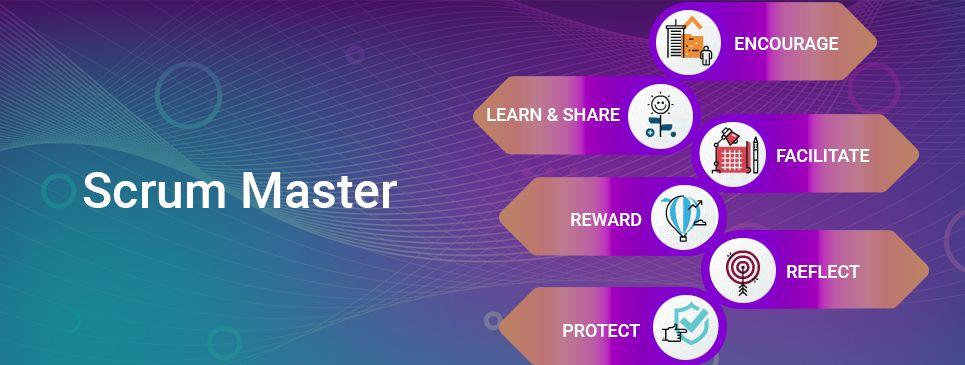February 21, 2019
Scrum Master Tutorial – Understanding Their Roles & Responsibilities
What is a Scrum Master and how does this role fit into a project? This question is critical for someone who wants to explore agile development.
In this post, you will learn what a Scrum Master is and how his role supports other members of an agile team.
What is a Scrum Master?
To understand the role of a Scrum Master, we need to gain an understanding of the Scrum process.
Scrum is a framework for effective collaboration of a team on developing sustainable software. This framework is based on the principles of Agile Methodology. Scrum allows establishing self-organizing teams that are quick to respond to changes.
(Must Read: Agile & Scrum Guide)
In the Scrum, there are sprints that last one to two weeks. The Scrum team delivers shippable software on a regular basis. After the end of each sprint, the stakeholders and development team conduct meetings to plan deliverables for the next sprint.

There are three critical roles in a Scrum
Roles in a Scrum:
Product Owner
Product Owner has the vision for the software to be built. A Product Owner focuses on business and market requirements. PO also keeps track of all the work that needs to be done.
Scrum Team
In a Scrum team, everyone has a set of tasks that they collaborate on to deliver shippable pieces of software. The Scrum Team gives estimates of the amount of work they can complete in each iteration.
Scrum Master
Scrum Master ensures that the team follows the Scrum process. He organizes meetings, deals with challenges & bottlenecks. He also interacts with Product Owner to formulate the product backlog for the next sprint. In a nutshell, a Scrum Master is a facilitator of agile development.
Scrum Master’s Role in the Scrum Process
Let’s have a closer look at the role played by a Scrum Master in agile development.
The Scrum process begins with setting product goals. Scrum Master collaborates with Product Owner to understand the vision for the software being built and the goals to be achieved.
The Scrum Master formulates “User Stories” with the help of Product Owner. User Stories explains what the user wants and why they want it. Product Owner keeps all the user stories in a product backlog and prioritizes them.
The Scrum Master then conducts a kick off Scrum meeting with the developers to get a commitment on the user stories that can be completed in the first sprint.
As the sprint starts, the Scrum Master conducts daily Stand up meetings with the development team to identify any challenges or issues that can delay work or result in a change of plans.
Scrum Master’s role during the sprint is to maximize productivity and handle any blocking issues which require inputs from Product Owner.
The Scrum Master also prepares the product backlog for the next sprint.
The whole Scrum Team meets at the end of the sprint to discuss the product backlog for the next sprint. This also includes proposing ideas that could improve efficiency in the next sprint.
A sprint is concluded by holding a demo of the software to the stakeholders. The Scrum Master collects feedback from the stakeholders to include it in the product backlog. An internal review meeting is also held with the development team to get their feedback on how to improve the development team.
As the shippable software is delivered sprint after sprint, the Scrum Master focuses on strategic aspects. This includes planning for the product backlog and developing a product road-map with the Product Owner.
Scrum Master Roles and Responsibilities:
- To facilitate daily scrum, sprint planning, sprint demo, and retrospective meeting.
- Resolve conflicts by focusing on scrum values of openness, honesty, and respect.
- Forecast the number of deliverable possible in an iteration based on evidence.
- Estimate and plan for the whole software development project
- Coach the team in agile practices; emphasize on individuals & interactions over process & tools.
- Help the team members in clarifying goals and actions to achieve the goals.
- Shield the team from any distractions and interference.
- Ensure the correct application of the scrum process.
- Scrum Master serves his team rather than direct the team.
The role played by Scrum Master during the whole Scrum process results in increasing the satisfaction levels of the end-user and customer.
How to become a Scrum Master?
To become a Scrum master, you need to go for a Certified Scrum Master (CSM) course. A CSM course will allow you to engage with other Scrum experts. The prerequisite to becoming a CSM are:
- Familiarize yourself with the Scrum process.
- Attend a CSM course which is taught by a Certified Scrum Trainer.
- To pass the CSM exam, you will have to answer at least 24 of 35 questions.
ReQtest is a tool build to support Scrum Masters in effectively undertaking their responsibility throughout the Scrum process. A Scrum Master can collaborate with the Product Owner in formulating the product backlog through ReQtest’s requirement module.
The Agile Board in ReQtest helps in planning and tracking deliverable during the sprint. The Scrum Master can create a new board for every sprint and assign the tasks to the Scrum Team. It also helps in tracking the deliverables.
The Bugs module in ReQtest helps to keep track of all the bugs that are derailing project progress. Scrum Masters also get graphical reports in ReQtest to keep track of the effectiveness of the development.
To know more about how ReQtest can be the go-to-tool for Scrum Masters, signup for a free trial.
Summary
A Scrum Master helps to enable the Scrum process and act as a facilitator of agile development. He acts like a pillar of support for the whole Scrum Team and coaches the team on agile principles.
(Interesting to read: Agile Software Development- 5 Trends to Watch Out For In 2019)
Share article